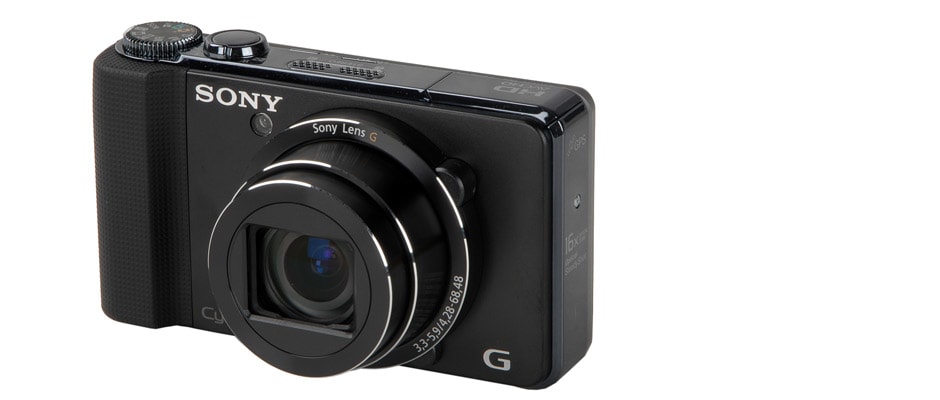Pros
Cons
Introduction
Front
{{section_header}}{{section.name}}{{/section_header}}

Back
{{section_header}}{{section.name}}{{/section_header}}

Sides
{{section_header}}{{section.name}}{{/section_header}}

Top
{{section_header}}{{section.name}}{{/section_header}}

Bottom
{{section_header}}{{section.name}}{{/section_header}}

In the Box
{{section_header}}{{section.name}}{{/section_header}}

In the box:
• Sony Cyber-shot DSC-HX9V digital camera
• AC / USB wall socket adapter
• USB cable
• battery pack NP-BG1
• warranty card
• software CD-ROM
• instruction manual
Color
{{section_header}}{{section.name}}{{/section_header}}
The HX9V is a highly accurate camera, and this will make all photos more realistic and lifelike, especially shots with human subjects. Our color test revealed an error rating of only 2.42, with oversaturation of only 2.6%. Inaccuracies, when they occur, are spread evenly across the spectrum, though blues are a little further off than the rest. More on how we test color.
These scores are the best in our comparison group, with the closest competition coming from Panasonic's ZS10. Fujifilm's F600EXR also scored fairly well in this test, while the otherwise-excellent Casio ZR100 lags behind.
Color Modes
{{section_header}}{{section.name}}{{/section_header}}
The HX9V may be set to one of five color modes, and the most accurate one is appropriately called Real. Both the Standard and Vivid settings cause saturation to spike, by 15% and 22% respectively. All of our remaining test shots were captured with the Real color mode.
Noise
{{section_header}}{{section.name}}{{/section_header}}
Undesirable image noise can pollute shots captured with high ISO values, but the HX9V does a great job keeping this to a minimum. Visual artifacts make up only 0.49% of images shot at ISO 100, and that figure doesn't cross 1.00% until ISO 1600. We also appreciate Sony's honesty regarding software noise reduction, which smooths away noise at the expense of fine detail. When noise reduction is necessary, the HX9V displays an icon indicating what degree of smoothing will be used. There's no way to actually adjust this software, but at least the camera lets you know what's happening to your shots. More on how we test noise.
The story is very much the same under low light. In our 60 lux test, noise levels were only 5% worse and, like the fully lit test, noise reduction behaved in a controlled and even-keeled way. Noise increases linearly across the ISO spectrum, without the odd peaks and valleys that noise reduction can cause.
Compared to the other models in this group, the HX9V's manifestation of noise is more blocky and digital, whereas the ZR100 is blurry, or the F600EXR is grainy. On the other hand, the HX9V is quantitatively ahead of most competitors, with very low artifacting rates. Only the Casio ZR100 posted a better score, and even then by a relatively small margin.
{{comparison_bars title="Noise Score Comparison", attribute="Noise Score", xLabel="Noise Score"}}
ISO
{{section_header}}{{section.name}}{{/section_header}}
ISO levels of 100 to 3200 are possible, with no extended or reduced resolution options available. This is a typical range, though the F600EXR does offer full resolution shooting at up to ISO 12800.
Resolution
{{section_header}}{{section.name}}{{/section_header}}
All of the HX9V's resolution scores are equal or better than the models in our comparison group, this comes at a price though. Harsh haloing and edge enhancement sometimes make corners and geometry ugly and unappealing, even though test scores are high. More on how we test resolution.
Distortion ({{product.raw_scores['Distortion Score']}})
Lens distortion is predictable and can be easily compensated for in software. So maximum scores like this one are not uncommon. This camera's distortion is worst at the closest focal length (minimum zoom), where we recorded 0.77% pincushion distortion. The figure drops to an imperceptible 0.06% barrel distortion at the maximum focal length.
Sharpness ({{product.raw_scores['Sharpness Score']}})
Like many cameras with ambitious zoom ratios, the HX9V boasts excellent resolution while zoomed out, but detail is lost as focal length increases. The camera is capable of resolving up to 2300 MTF50's at the widest angle, but this drops to about 1500 during telephoto shooting. Despite the gap, this is still the best result of our comparison group, surpassing all others by a wide margin. The Panasonic ZS10 is especially weak here, coming away with less than half the points of the HX9V.
Chromatic Aberration ({{product.raw_scores['Chromatic Aberration Score']}})
Blue fringing is often present in shots captured at mid and telephoto zoom. This compounds with the camera's tendency to halo around areas of high contrast, sometimes creating unattractive, imprecise edges. But our lab tests can only measure detail, they can't distinguish gorgeous shots from ugly ones, so the HX9V earns the best score of our comparison group.
Quality & Size Options
{{section_header}}{{section.name}}{{/section_header}}
Four 4:3 options and two 16:9 options are available for shooting, including low resolution dimensions for saving memory space. The HX9V is not capable of shooting with lossless RAW encoding, and no JPEG compression quality settings exist.
Image Stabilization
{{section_header}}{{section.name}}{{/section_header}}
While this Cyber-shot does include an effective image stabilizer, the feature may only be set to Standard and Active modes. There is no "off" setting, and this leaves us with no control data to test from. We therefore cannot award any points to the HX9V for this metric.
We ran the test anyway though, and learned the Active setting is approximately 12% more effective than the Standard one, so we do recommend using this option when appropriate. More on how we test image stabilization.
The most effective stabilizer in this comparison group belongs to the Fujifilm F600EXR, which is capable of boosting image quality by a whopping 70%. Our scores also suggest the Panasonic ZS10 has an excellent stabilizer, however this camera's detail was so low to begin with that the 57% improvement isn't impressive.
{{comparison_bars title="Stabilization Score Comparison", attribute="Stabilization Score", xLabel="Stabilization Score"}}
Video Mode
{{section_header}}{{section.name}}{{/section_header}}
The HX9V is an advanced video device, capable of recording 1080/60p video. Optical zoom is unlocked while shooting, but speed has been slowed way down to prevent mechanical noise. It's also possible to capture 16:9 stills while a recording is in progress. A full stereo microphone on the top of the body also helps add some depth to clips.
Video Color
{{section_header}}{{section.name}}{{/section_header}}
Color accuracy during video takes an absolute nosedive compared to still shooting. In our lab test, the HX9V's error value shot up to 8.16, a terrible score even compared to other cameras' video modes. Saturation, at least, is still dead on. We registered an average oversaturation of only 1.8%. More on how we test video color.
{{comparison_bars title="Video Color Score Comparison", attribute="Video Color Score", xLabel="Video Color Score"}}
Video Sharpness
{{section_header}}{{section.name}}{{/section_header}}
Thanks to the high resolution sensor, sharpness during video is actually quite strong. The camera is capable of resolving 625 lw/ph of detail horizontally and 700 vertically. Great numbers, however they're exceeded by the Casio ZR100, which specializes in video. More on how we test video sharpness.
{{comparison_bars title="Video Color Sharpness Comparison", attribute="Video Sharpness Score", xLabel="Video Sharpness Score"}}
Playback Mode
{{section_header}}{{section.name}}{{/section_header}}
Image review mode is fairly typical, operated by a combination of the directional pad and zoom lever. There's fullscreen with 8x magnification, grid display, and calendar display modes. Access speed is quick once the menu is going, but actually popping in and out of playback mode causes an annoying three second delay.
In-Camera Editing
{{section_header}}{{section.name}}{{/section_header}}
It's possible to resize and rotate shots, or apply red eye correction from the playback menu. Unsharp masking is also offered, which adds a sharpening effect to a given image. These four options are the full extent of the HX9V's in-camera editing functionality.
Direct Print Options
{{section_header}}{{section.name}}{{/section_header}}
DPOF tagging is supported for single and multiple images, and the interface is clean and quick. Be aware that support for the popular PictBridge standard is not listed, so the HX9V may not be immediately compatible with your home printer.
Display
{{section_header}}{{section.name}}{{/section_header}}
The 3-inch touchscreen dominating the rear panel is a 921,600-dot model that offers rich, high contrast playback for an embedded device. Colors aren't totally accurate, but we only noticed the problem once or twice. The screen's plastic coating is also glare resistant, and all this makes for an excellent viewing experience.

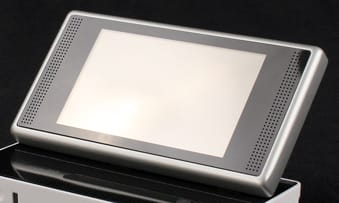
...but it turns into a nice 3-inch widescreen in playback mode.
Flash
{{section_header}}{{section.name}}{{/section_header}}
The HX9V's flash assembly is full motorized, as seems to be the trend these days. This means that the pop-up bulb both extends and retracts automatically based on menu settings. When this happens, it often knocks out our grip with the left hand. Then again, this camera's noise performance is excellent, so shooting with the flash won't always be necessary.
The emitter itself is powerful for a camera of this size, effective out to 18 feet. A slow synchro option is available, however a red-eye reduction setting is notably absent.

The flash emitter pops up from the top of the body via a mechanical release.
Lens
{{section_header}}{{section.name}}{{/section_header}}
Another rising trend these days is to surround your lens elements with a reflective chrome bezel. The HX9V has a few such rings and, like many others, they often reflect light right back onto your subject, creating distracting bright spots. The enclosure itself feels sturdy enough, but would definitely break if dropped in the extended position.

16x is among the most impressive zoom ratios we've seen from a camera in this class. In the reference shots below, you'll notice this equals about 50 or 75 yards at ground level. More than enough for sporting events and light wildlife photography.
Battery
{{section_header}}{{section.name}}{{/section_header}}
The included NP-BG1 rechargeable battery pack is rated at 300 still shots, way above average for a camera of this size. We can't definitively confirm this incredibly high figure, but the HX9V did survive our entire suite of tests on only one charge.
Unfortunately the battery compartment hardware is not nearly as impressive. The pack has a tendency to become stuck in its slot. Very stuck. Like "shake the camera as hard as you can" -stuck. We imagine this won't be a huge problem for most, since charging is accomplished with the included AC / USB adapter, or by simply plugging the unit into a computer, so taking out the battery is never really necessary. Still, we shouldn't have to risk damaging our hardware to perform such a mundane action.

Memory
{{section_header}}{{section.name}}{{/section_header}}
The HX9V is dual compatible with SD memory cards and Sony's own Memory Sticks. SD, SDHC, and SDXC cards are all supported, as well as PRO Duo, PRO-HG Duo, and Duo Memory Sticks. The camera also features 19 MB of emergency internal memory, but this is only enough for three full resolution shots.

Jacks, Ports & Plugs
{{section_header}}{{section.name}}{{/section_header}}
A mini-HDMI port is housed underneath a plastic terminal cover at the top of the right panel, useful for streaming photos and 1080/60p videos to an HDTV. There's also a proprietary USB terminal located–rather inconveniently–on the bottom of the camera, in between the tripod mount and the battery slot cover.
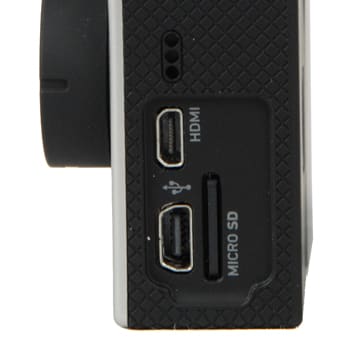
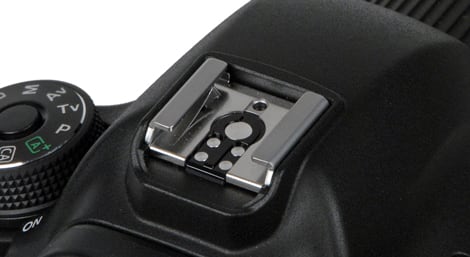
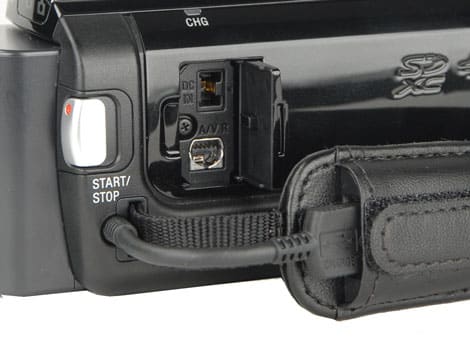
The DC-input and multi-AV port are located on the right side of the camcorder.
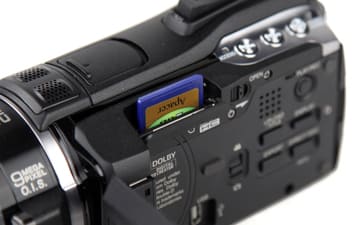
... as is the SD/SDHC card slot.
Other Hardware
{{section_header}}{{section.name}}{{/section_header}}
GPS Transceiver
We wouldn't recommend buying this camera specifically for the GPS functionality. We're awarding a point and a half for including the feature, but we couldn't actually get the service working properly during our (admittedly short) time with the camera. Performance here is going to be based on a number of unpredictable variables, it may work for you, it may not.
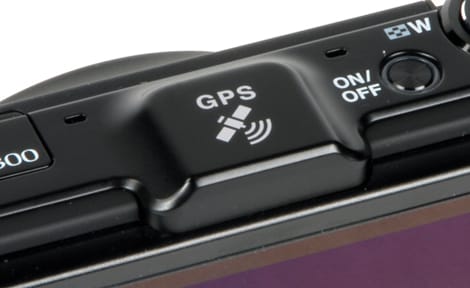
The new GPS module.
Shooting Modes
{{section_header}}{{section.name}}{{/section_header}}
A hardware mode dial rests atop the rightmost part of the top panel, but the dial is somewhat difficult to operate and is situated so close to the shutter release that the two are easily confused. Two different automatic modes are available, Intelligent Auto and Superior Auto. Both recognize scenes on the fly, and adjust settings accordingly, but Superior Auto aims to reduce noise and motion blur more aggressively. We also get a custom setting, called Memory Recall, as well as a dedicated panorama mode, 3D shooting mode, and a few others.

The full mode dial is nice, but frequently rotates by accident.
Scene Modes
15 scene modes are available but many of them are redundant. Anti Motion Blur, for example, adjusts shooting variables to take further advantage of the already-active image stabilizer. Another one, High Sensitivity, doesn't seem to unlock ISO levels higher than the existing maximum of 3200. On the other hand, Backlight Correction HDR is one example of an excellent scene mode, which brackets three shots and then combines them for a simple high dynamic range shot without any post processing by the user.
Picture Effects
{{section_header}}{{section.name}}{{/section_header}}
Effects are also included in the same catch-all menu as scene modes. Options aren’t numerous, but do include a few favorites like Fish-eye, Miniature Effect, Toy Camera, and Color Swap. Some effects aren’t as impressive as others. Poster Effect, for example, produces a pretty weak, unconvincing result.
Manual Controls
{{section_header}}{{section.name}}{{/section_header}}
The HX9V has no mechanically manual controls, but the zoom lever surrounding the shutter release is close. It adjusts the focal length in a smooth and relatively precise way for a compact camera. Beyond this, there are no shutter or aperture priority modes, but a full manual mode is available. Strangely, aperture cannot be adjusted in steps, and must be selected from either the widest or narrowest setting at a given focal length.
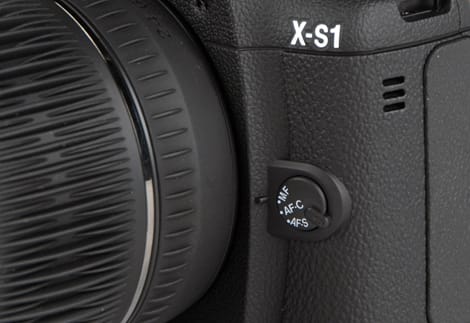
A dedicated focus-mode switch on the front panel.
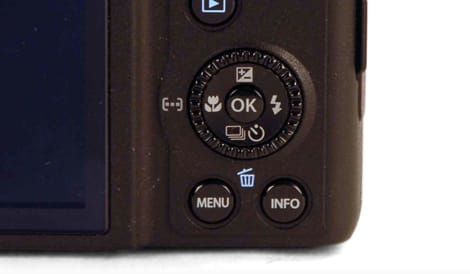
The scroll wheel surrounding the d-pad is neither awful nor perfect.
Drive/Burst Mode
{{section_header}}{{section.name}}{{/section_header}}
The self-timer may be set to 10-second or 2-second countdowns, or set for one or two person self-portraits that use face detection to start the countdown automatically. EV and white balance bracketing modes are also supported, as are two speeds of burst mode shooting, with a capacity of ten shots.
Shot to Shot ({{product.raw_scores['Shot to Shot Score']}})
The HX9V's high speed burst mode is capable of precisely 10 frames per second, exactly the speed Sony claims. At ten shots this gives you a one second window to capture the decisive moment. The camera also has a 2 frame per second burst mode, but we never used it.
Handling
{{section_header}}{{section.name}}{{/section_header}}
Some effort has been invested in physical handling of this camera's body, the results are hit or miss. A raised and rubberized hand grip wraps around the right side of the front panel and half of the right panel. We like this, but the raised portion is too skinny to grip comfortably with an adult-sized hand.

On the rear panel, a large thumb rest separates the main control layout from the movie hotkey. The area is positioned and angled to catch the knuckle correctly, and this makes for a balanced and stable shooting grip, even one-handed. It's still possible to strike the movie button accidentally though.



These dedicated buttons give you quick access to aperture and shutter speed controls.
Buttons & Dials
{{section_header}}{{section.name}}{{/section_header}}
The shutter release on top of the body has a decent feel for a compact camera, with a long autofocus stage and good tactile feedback. Next to that, the on / off and custom buttons are both flush with the body, making them difficult to press and easy to mistake for one another.

Below the thumb rest on the rear panel, the circular directional pad also functions as a rotating dial, although this is mostly pointless given the camera's general lack of precise manual control. Some of the surrounding buttons, like the menu button and especially the playback button, aren't robust enough to press comfortably, requiring some use of the fingernail.

Menus
{{section_header}}{{section.name}}{{/section_header}}
Sony's current menu system is a tab-based interface that makes more good decisions than bad. A quick menu is accessed by pressing the menu button, allowing immediate adjustment of the most common shooting variables. The bottom position on this menu accesses the main menu, which gets into more detail but takes a bit longer to operate.
The quick menu, despite the camera's high resolution LCD, uses icons that are too large. This is probably in the interest of legibility, but actually prevents many options from being shown onscreen at the same time. If you imagine driving a car but only being able to see five yards ahead, you'll understand why this slows down navigation. Sony has also separated the settings of a few functions in confusing ways. For example, the drive hotkey on the directional pad chooses between single, burst, and bracket shooting; but specific settings for each of these modes requires navigating to a separate menu option, rather than drilling down to the necessary settings right then and there.
But these are nitpicks that won't deter someone who's already enjoying the HX9V. An imperfect but strong menu interface overall.
Manual & Learning
{{section_header}}{{section.name}}{{/section_header}}
The HX9V ships with an insultingly short and unhelpful instruction manual, and no expanded version is available online or on the included CD-ROM. While the camera's internal guide system is very robust, nothing can replace an old fashioned manual for detailed information. To be frank, you're better off reading this very website than looking to Sony's pamphlet for advice.
Fujifilm FinePix F600EXR Comparison
Both of these are excellent travel zooms, so a purchase decision will probably depend entirely on usage expectations. Casio's ZR100 offers exemplary secondary features, such as burst mode shooting and high speed video. But the HX9V takes sharper, more accurate photos under typical circumstances.
Handling of noise may also be a determining factor. Both cameras posted excellent noise scores, but noise produced by the ZR100 has a tendency to blur, while the HX9V's has a digitizing effect. All image noise is destructive, but this is more of a stylistic issue based on personal preference.
The ZR100 has also had plenty of time to drop in price, and is now significantly less expensive than the HX9V. Depending on what kind of shooting you plan to do, the extra expense may or may not be worth it.
Panasonic Lumix DMC-ZS10 Comparison
Fujifilm's F600EXR is significantly less expensive than the HX9V, and price is likely to be the determining factor between these two. Most of the F600EXR's scores were worse. Less accurate colors, more noise, less sharpness, more chromatic aberration, etc. But almost all of those scores are very close, and customers will have to ask themselves if those many minor performance benefits are worth nearly $100 extra. We'd call this one a toss-up.
COMP 3
Panasonic's ZS10 is an aging travel zoom that offers the same 16x magnification and built-in GPS as the HX9V, at a price that's had plenty of time to drop. Test scores were much worse however, so the lower cost definitely translates into a loss of image quality. Price would've given this model a fighting chance, were it not for the Fujifilm F600EXR, a better, reasonably-priced alternative to the HX9V. Now that the F600EXR is on the market and we've tested it, there's little reason left to recommend the ZS10.
Conclusion
Iterating in subtle ways over the HX7V, Sony's new Cyber-shot DSC-HX9V aims to be none other than the very best travel zoom camera currently on the market. And what we really appreciate about this model is that the company has dared to achieve this goal using little except pure image quality. Extra features and effects, while still present, don't stand out to the point of distraction and certainly aren't there to sell the camera. GPS is available if you want it, in-camera editing is simple and functional, but let's praise this model for its real strength: capturing gorgeous photos.
The first thing you'll notice when shooting with the HX9V is its ability to render sharp, fine details. Surfaces like cracked asphalt or the bark of a tree leap out at the viewer, creating a sense of presence that is usually reserved for more expensive models. Aiding this is the sensor's highly realistic representation of color, which reproduces subjects–especially human ones–accurately to how they appear in real life.
Operating the HX9V is largely free of frustration. Optical zoom is this camera's key feature and the precise zoom lever makes usage a breeze. Two levels of image stabilization don't just prevent blurry shots, they assist with framing as well. Advanced shooting features like burst mode and full manual control round out the package, and the menu interface is imperfect but solid overall.
We'd say the camera's most significant drawback is the technique used to reduce unwanted image noise. While it's true the HX9V aced our noise test, the way this camera's smoothing software gets rid of noise is decidedly angular and digitized. All compact cameras need noise reduction, some blur, others smudge, but the HX9V pixelates. Combined with the camera's tendency to "halo" edges, this can create an ugly rendering up close.
But on the whole, we respect Sony's prioritization of image quality over fluff, and regard their efforts as a resounding success. The DSC-HX9V is arguably the finest travel zoom on the market, and a great value even at the above-average price.
Comparisons
Photo Gallery
{{photo_gallery "Front Photo", "Back Photo", "Sides Photo", "Top Photo", "Bottom Photo", "Lens Photo", "Flash Photo", "EVF Photo 1", "EVF Photo 2", "LCD Photo 1", "LCD Photo 2", "Media Photo", "Modes Photo", "Manual Controls Photo", "Manual Controls Photo 2", "Other Controls", "Buttons 1", "Buttons 2", "Other Hardware Photo", "Battery Photo", "Ports Photo 1", "Ports Photo 2", "Ports Photo 3", "Ports Photo 4", "Handling Photo 1", "Handling Photo 2", "Handling Photo 3", "Box Photo"}}
Meet the tester
Chris was born and raised less than ten miles from our editorial office, and even graduated from nearby Merrimack College. He came to Reviewed after covering the telecom industry, and has been moonlighting as a Boston area dining critic since 2008.
Checking our work.
Our team is here to help you buy the best stuff and love what you own. Our writers, editors, and experts obsess over the products we cover to make sure you're confident and satisfied. Have a different opinion about something we recommend? Email us and we'll compare notes.
Shoot us an email